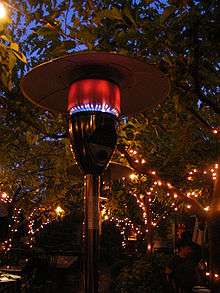Patio heater
A patio heater (also called a mushroom or umbrella heater) is a radiant heating appliance for generating thermal radiation for outdoor use.

Types of heater
A burner on top of a pole, it burns liquefied petroleum gas (LPG), propane or butane, and directs the flames against a perforated metal screen. Heat is radiated from the surface of the screen in a circular pattern around the appliance. A reflector a top the burner reflects heat that would be otherwise lost upwards. This is because the reflecting hood is usually silvered which makes it a poor absorber of heat but excellent at reflecting infrared radiation back. This reduces the amount of heat lost by conduction as silvered surfaces will not absorb infrared light. The chimenea is an alternative to the patio heater for home use, which burns wood instead of gas.
Some newer types of patio heaters are electrically powered radiative heaters that emit infrared energy onto nearby surfaces, which in turn heat up the surrounding air.
Other styles of outdoor patio heaters include:
- Wall-mounted patio heater[1]: fixed to a wall or structure making for safe operation
- Hanging patio heater: portable and small footprint; comes in electric only
- Tabletop patio heater: ultra-portable and great for smaller groups or outdoor dining, but it uses a small propane tank
Patio heaters have become popular with bars and restaurants, since they extend the day and the season for their customers to sit outdoors. This increase in the popularity of the patio heater has led to concerns over their environmental effects. One patio heater can produce four tons of carbon dioxide annually.[2]
Climate issues
The use of external heaters outside cafes has been banned in various cities in France, due to environmental concerns,starting with Rennes.[3] Previous attempts were overturned in the courts.[4] Alternative sustainable solar solutions have been proposed.[4]
Propane coverage
| Area | Distance from heater | Propane and natural gas heaters | Electric heaters |
|---|---|---|---|
| 4 sq ft | 1 foot | 10,000 BTUs | 1,000 Watts |
| 16 sq ft | 2 feet | ||
| 36 sq ft | 3 feet | ||
| 64 sq ft | 4 feet | ||
| 100 sq ft | 5 feet | 46,000 BTUs | |
| 144 sq ft | 6 feet | 1,500 Watts | |
| 196 sq ft | 7 feet | ||
| 256 sq ft | 8 feet | ||
| 324 sq ft | 9 feet | Requires additional heater | |
| 400 sq ft | 10 feet | Requires additional heater |
Fuel types
Propane fuel
Propane patio heaters are the most popular type, as they are portable and easy to find refill locations such as gas stations or convenience stores. The downside to propane is that you need to purchase a separate tank for each heater you own and can be more costly to operate than electric or natural gas.
Natural gas fuel
Natural gas patio heaters are great solution, as more and more houses come outfitted with natural gas lines. This makes it very convenient to hook into; however, it is less portable than propane. Extension hoses are available but can be a tripping hazard, especially after the sun has gone down.
Electric
Electric patio heaters are a great choice for easy setup, and has indoor applications as well, for partially enclosed indoor-outdoor space. Electric heaters are typically generally a bit weaker; therefore, it’s best for a small group of people.
See also
References
- "The Most Energy Efficient Patio Heater on the Market". Yandiya Australia. Retrieved 16 May 2019.
- Macbride, Peter (24 June 2011). Get an Ethical Life: Flash. Hachette UK. p. 3. Retrieved 28 August 2013.
- https://www.telegraph.co.uk/news/2020/01/03/outdoor-heaters-banned-french-city-tackle-climate-change/
- https://www.smartcitiesdive.com/ex/sustainablecitiescollective/last-sustainable-alternative-gas-patio-heater/206751/
| Wikimedia Commons has media related to Patio heaters. |